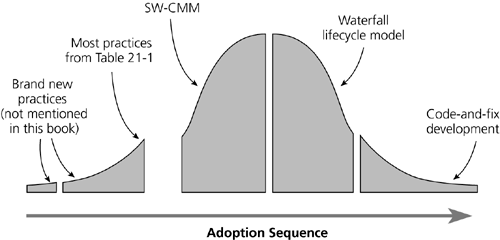Where s the Risk?
Where's the Risk?The conventional wisdom is that if you're a risk taker, you'll be to the left of the chasm. If you're risk averse, you'll be to the right of the chasm. But this conventional wisdom doesn't apply very well to current software engineering. As Figure 21-3 illustrates, the practices from Table 21-1 are currently being used by Innovators and Early Adopters. The figure also shows a few specific practices to establish some reference points. The SEI's SW-CMM model seems to be crossing the chasm. The well-known waterfall lifecycle model is in Late Majority territory, and code-and-fix development is well into Laggard territory. Figure 21-3. Different software development practices are at different stages in the innovation adoption sequence. The practices in Table 21-1 are ready to cross the chasm. The SW-CMM is in widespread use in some industries but is virtually unknown in other industries (that is, it has crossed the chasm in some industries but not in others). Older practices such as code-and-fix development are on their way out (or at least they should be).
The state of the art in software engineering has advanced by leaps and bounds since the 1968 NATO Conference on Software Engineering. But we still find many organizations using practices that are 10 to 20 years out of date or more and which could be replaced by better practices. The industry is confronting a problem of slow diffusion. I've mentioned elsewhere that organizations that use these old practices face a high risk of cost overruns, schedule overruns, and project cancellations. I repeat that fact here to emphasize that occupying one of the later adopter roles in the software field is not currently minimizing risk for the organizations in those positions. Just as it's possible to spend more on repairs for an old car that keeps breaking down than on payments for a newer one, it's possible to incur more risk by using out-of-date software development practices than by moving to newer, better practices. Where do you want to be on the technology transfer cycle? As Figure 21-4 illustrates, on the far left, accepting the risk of promising but as-yet-unproved innovations is justified because the innovations might yield high payoffs. On the far right, the risk from using outdated practices is equally high, but there's no potential for high payoffs and the risk isn't justified. Figure 21-4. Considering the rate at which software practices have improved, the traditional innovation risk/reward payoff has gotten out of balance. Both extremes of the innovation adoption curve present high risk.
The software industry is in an unusual technology-transfer situation. Many innovative practices that have proved their value, such as those in Table 21-1, have congregated on the left brink of the chasm. They are ready to cross for organizations that are willing to kick their addiction to code-and-fix development and other kinds of software fool's gold. This situation is unusual because typically the risk of being an Early Adopter would be higher. It's as if leading-edge doctors had tested penicillin, found it to be effective, and integrated it into their practices only to have 75 percent of doctors continue to use leeches and mustard poultices. If you're still using leeches and poultices at the beginning of the 21st century, you're taking on more risk by refusing innovations than by adopting them. If your organization is currently in the Early Majority, Late Majority, or Laggard categories, you can lower your risk by adopting some of the modern practices listed in Table 21-1. Using code-and-fix development is risky. Using the waterfall model is risky. Adopting the SW-CMM is somewhat risky, but not as risky as these older practices. Industry experience cited throughout this book shows this claim to be true. The difficulty is diffusing the message out into the field. |
EAN: N/A
Pages: 164

